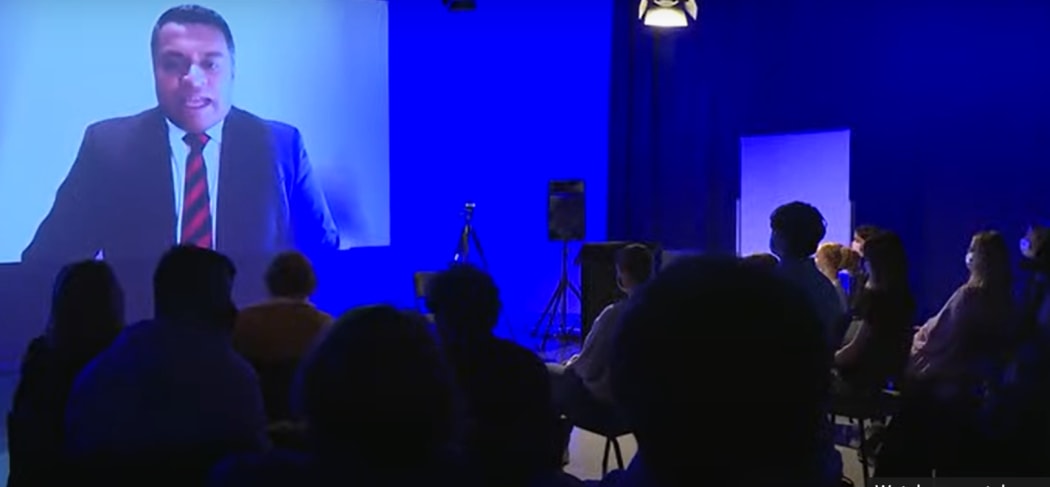The government has confirmed it is creating a new public media entity incorporating RNZ and TVNZ. But it has not revealed details of its funding - or the charter which will govern its operations.

Broadcasting minister Kris Faafoi announcing the new public media entity today. Photo: screenshot / YouTube
Minister of broadcasting and media Kris Faafoi said the new broadcaster will be "an autonomous Crown entity" operational by July 2023, which will have both commercial and Crown funding.
The new entity will be not-for-profit and will operate under a charter which will be set out in legislation due by the end of this year, Faafoi said. (Details of consultation carried out on a new charter for the new organisation were also published today)
It will have "complete editorial independence" and provide news as a core service, while broadcasting on a range of platforms "including current radio and linear TV and those of third parties".
"We know the media landscape is changing and the sector is having to adapt to increased competition, changing audience demands and ways of accessing media, falling revenue, and new and emerging digital platforms. We need public media which is responsive to these changes and can flourish.
“RNZ and TVNZ are each trying to adjust to the challenges, but our current public media system, and the legislation it’s based on, is focused on radio and television," Faafoi said.
Faafoi confirmed TVNZ and RNZ will initially be subsidiaries of the new organisation.
Faafoi had accepted advice from the Business Case Governance Group he appointed in March 2021, led by former NZ First MP Tracey Martin, ahead of the decision to create the new public media entity.
He confirmed that advertising will be part of its funding mix but "services which are currently commercial-free will remain so."
“In plain English, RNZ and RNZ Concert will continue. In plainer English, the government is committed to them,” he said.
The commitment to retain RNZ Concert follows a controversy in 2020, when RNZ proposed to cut its output and use its FM frequency for a new youth network.
That proposal was scrapped after a public outcry, and the minister said later youth network plans were "parked" because of the move to create a new media entity.
Faafoi signaled that the new entity would have a stronger presence online, partly in an attempt to target those younger and more diverse audiences which are currently disengaged from public media.
“We need to do better for younger audiences and we need to do better for minority and ethnic audiences.”
A board will be appointed next month to oversee the detailed design of the new public media entity, Faafoi said. He said it would include RNZ and TVNZ staff and also "shop floor" representation of the broadcasters' staff.
The balance of Crown and commercial income will be crucial to how the new entity operates, but the level of Crown funding is also not known.
"Government funding decisions will be made as part of Budget processes," the minister said.
Financial details are redacted from documents released today including the Cabinet Paper to establish a new public media entity, a Cabinet minute on the business case released today and the Business Case Governance Group report.
RNZ CEO Paul Thompson told Mediawatch he was till in the dark about public funding.
"I have had no visibility around the financial implications and modeling of the new entity - but it's really important that the organisation is sustainably funding funded, and can deliver that those public media outcomes," he said.
How can RNZ plan for the future without knowing that?
Previous Labour-led governments have made short-term efforts to boost on public service TV, but they didn't last.
"This is such a comprehensive piece of policy . . . on a much bigger public media outlet and that that's what will drive the decisions around funding because it has to be adequately and sustainably funded. I would hope that this is a bit of a turning point, given the challenges that we face as a nation, the challenges our media sector faces that this is the point where we do get at sustainable commitment," he said.
Mixed response to merger announcement
Peter Thompson, Associate Professor in Media and Communication at Victoria University of Wellington, said the announcement left the big questions of the new entity’s structure and funding unanswered.
"He's delegated the first issue of organisational structure to a new establishment committee that's yet to be established, and the funding issue appears to have been left to the Budget. The difficulty there is that the organisational structure and the funding arrangements have to be understood as interlinked. You can’t determine those independently.”
Thompson was worried about public media having to compete with things like transport, health, and education in that Budget process.
It would likely end up competing for scraps after funding had been allocated to those headline issues, he said.
“Public media services are always the runt of the litter. They’re always a “nice to have” that gets considered after the allocations to the major portfolios. The risk here is that history repeats itself, and as happened with the TVNZ Charter, you don’t back the public service vision with sufficient funds to off-set commercial priorities”.
In a statement, TVNZ welcomed the government's commitment to retaining its commercially funded content.
"We’re pleased the announcement has confirmed the dual funded nature of the new entity," the statement said.
"We expect the core of our business operations will remain the same, however the new structure will provide us with the opportunity to speed up some of our plans and ambitions."
RNZ's chairman Jim Mather also hailed the merger as a chance to create a public media service with the strength and scope to compete in a "rapidly changing global media market".
“We believe this is a once-in-a-generation opportunity to establish a new public media entity that will have the mandate, scope and resources to provide essential public media services to all the people of Aotearoa New Zealand.”


